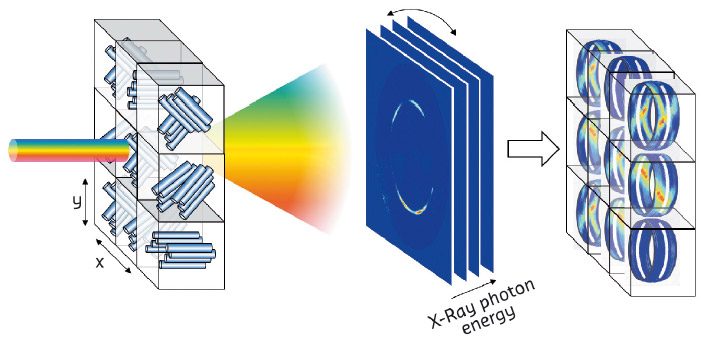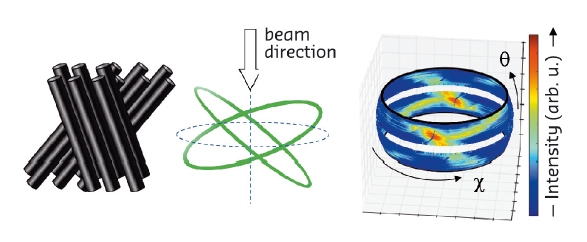- Home
- Users & Science
- Scientific Documentation
- ESRF Highlights
- ESRF Highlights 2016
- Complex systems and biomedical sciences
- X-ray colour provides direct 3D information in crystallographic texture measurements
X-ray colour provides direct 3D information in crystallographic texture measurements
Preferred crystal orientation, crystallographic texture, is a common phenomenon in complex materials. Conventionally, texture determination by X-ray diffraction involves many 2D diffraction images combined into 3D information by sample rotation. We have shown that the photon energies ("X-ray colours") in a white beam can be exploited to gain direct 3D crystallographic information in texture measurements. The method was used on carbon fibres and lobster cuticle.
For many decades, crystallographic texture has been measured by X-ray diffraction involving a monochromatic beam and area detectors delivering intensity information and hence “grey-scale” diffraction images. True 3D information about crystallite orientation could only be obtained by rotating the sample in the beam and by collecting diffraction images at different rotation angles. This puts severe limitations on the exploration of complex materials, since the local crystallographic texture may change dramatically from one point to the next, even on the micrometre scale.
A new class of pixelated X-ray area detectors now allows the discrimination of different photon energies in every pixel (pnCCD type detectors, SLcam) [1] and, together with a polychromatic X-ray beam, yields “X-ray colour images” [2]. In diffraction experiments, different photon energies can be used to collect information from different crystal plane orientations due to the sensitivity of the diffraction condition to both crystallite orientation and incident energy (known from white beam Laue diffraction). In contrast to conventional “grey scale” Laue patterns, the X-ray colour approach, energy dispersive Laue diffraction, EDLD [3], yields one-shot 3D orientation information even for complex and highly polycrystalline samples.
Within a research project supported by the Partnership for Soft Condensed Matter (PSCM), we used EDLD for crystallographic texture measurements. At BM28, we employed the full white beam from the bending magnet together with an energy dispersive X-ray camera and a setup accessing a wide range of scattering angles, i.e. a large angle portion of reciprocal space. The principle is shown in Figure 110.
 |
|
Fig. 110: EDLD texture measurement: a sample with locally different crystal orientations is raster scanned with a polychromatic beam. The energy dispersive X-ray camera delivers an energy spectrum for each pixel, which can be regrouped into a stack of diffraction images at different energies. The local 3D scattering pattern can be displayed directly for each beam position in the sample. |
The sample was raster scanned and the conventional 2D diffraction information was complemented by an energy spectrum recorded for each pixel. By using a straightforward reconstruction algorithm based on the Ewald sphere geometry, the photon energies were used to calculate the missing third dimension in space. In this way, a 3D representation of scattering data was achieved without a priori knowledge of the sample and without sample rotation.
We applied the new texture measurement method to map the orientation of graphite planes in carbon fibres and of calcite crystallites in lobster cuticle. The example of two crossed strands of carbon fibre is shown in Figure 111. The two orientations are immediately visible from the 3D reconstruction of the scattering image. In lobster tail cuticle, the method revealed a calcite crystal orientation roughly perpendicular to the cuticle plane. At the same time, it allowed determination of the Ca distribution, since the energy dispersive detector also records the X-ray fluorescence from the sample and thus yields chemical information as well.
 |
|
Fig. 111: Example of EDLD texture measurements on two crossed carbon fibre bundles (left). In reciprocal space, each carbon fibre yields a reflection ring from the (002) graphite planes perpendicular to the fibre axis (fibre texture). The crossed rings are observed directly in the 3D scattering patterns (right) and can be used to reconstruct the carbon fibre orientations. |
In this way, 3D crystallographic and chemical information could be acquired in a single shot, without sample rotation and at a lateral spatial resolution only limited by the beam size. The method is therefore of particular value for fast 2D texture mapping of complex samples or for any setup or system that does not allow rotation. The approach combines the benefits of both traditional Laue diffraction and monochromatic diffraction, and can therefore be expected to become a powerful and elegant tool in future crystallography, applied chemistry and materials science.
Principal publication and authors
Photon energy becomes the 3rd dimension in crystallographic texture analysis, T.A. Grünewald (a), H. Rennhofer (a), P. Tack (b), J. Garrevoet (c), D. Wermeille (d,e), P. Thompson (d,e), W. Bras (f), L. Vincze (b) and H.C. Lichtenegger (a). Angewandte Chemie Int. Ed. 55, 12190–12194 (2016); doi: 10.1002/anie.201603784.
(a) Institute of Physics and Materials Science, Department of Materials Sciences and Process Engineering, University of Natural Resources and Life Sciences – BOKU, Vienna (Austria)
(b) Department of Analytical Chemistry, Ghent University (Belgium)
(c) Deutsches Electronen Synchrotron, Hamburg (Germany)
(d) XMaS -The UK CRG Beamline, ESRF, Grenoble (France)
(e) Department of Physics, University of Liverpool (UK)
(f) Netherlands Organization for Scientific Research (NWO), DUBBLE@ESRF, Grenoble (France)
References
[1] O.Scharf et al., Analytical Chemistry 83, 2532-2538 (2011).
[2] P. Tack et al., Analytical Chemistry 86, 8791-8797 (2014).
[3] S. Send et al., J. Appl. Cryst 42, 1139-1146 (2009).



